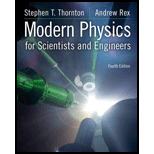
Frequency of the signal received in beginning
Answer to Problem 39P
frequency of the signal received in beginning is
Explanation of Solution
Initially the signal sent by Marry will be received by the Frank. The source emitting n waves in a time interval T, here Marry going away with velocity (v) from frank that is source is moving away from observer
Write the equation to get the distance travelled by a signal. Thus,
Write the equation to get the wavelength of waves emitting n waves in a time interval T and travelling a distance d in that time interval. Thus,
Write the equation to show the relation between frequency and wavelength. Thus,
Where, c is the speed of the light, f is the frequency of the waves, and
Substitute the value of wavelength from equation (II) in above equation. Thus,
Write the equation to get the total number of the signals in time interval
Where,
Substituting the value of n from equation (IV) in equation (III). Thus
Substitute the
Because
Initially Marry and Frank receives same frequency.
At the end of the trip Marry going away from Frank thus,
Thus, marry initially receives signals at a rate of
And, Frank initially receives signals at a rate of
Where, L is the distance of the Marry’s Journey from earth to star
Conclusion:
Therefore, frequency of the signal received in beginning is
Want to see more full solutions like this?
Chapter 2 Solutions
Modern Physics for Scientists and Engineers
- What two measurements will two observers in relative motion always agree on?arrow_forwardThe mass of the fuel in a nuclear reactor decreases by an observable amount as it puts out energy. Is the same true for the coal and oxygen combined in a conventional power plant? If so, is this observable in practice for the coal and oxygen? Explain.arrow_forward(a) Show that (pc)2/(m c 2)2=21. This means that at large velocities pcmc2. (b) Is Epc when =30.0, as for the astronaut discussed in the twin paradox?arrow_forward
- In the Check Your Learning section of Example 27.1, the author commented that even at z=0.2 , there is already an 11% deviation between the relativistic and the classical solution. What is the percentage difference between the classical and relativistic results at z=0.1 ? What is it for z=0.5 ? What is it for z=1 ?arrow_forwardAn observer sees two events 1.5108s apart at a separation of 800 m. How fast must a second observer be moving relative to the first to see the two events occur simultaneously?arrow_forwardGiven the fact that light travels at c, can it have mass? Explain.arrow_forward
- An astronaut moves away from Earth at a speed close to the speed of light. If an observer on Earth could make measurements of the astronauts size and pulse rate, what changes (if any) would he or she measure? Would the astronaut measure any changes?arrow_forwardConsider the relativistic form of Newtons second law. Show that when F is parallel to v, F=m(1v2c2)3/2dvdt where m is the mass of an object and v is its speed.arrow_forwardOne cosmic ray neuron has a velocity of 0.250c relative to the Earth. (a) What is the neutron's total energy in MeV? (b) Find its momentum. (c) Is in this situation? Discuss in terms of the equation given in part (a) of the previous problem.arrow_forward
- Calculate the momentum of a proton moving with a speed of (a) 0.010c, (b) 0.50c, (c) 0.90c. (d) Convert the answers of (a)(c) to MeV/c.arrow_forwardA yet-to-be-built spacecraft starts from Earth moving at constant speed to the yet-to-be-discovered planet Retah, which is 20 lighthours away from Earth. It takes 25 h (according to an Earth observer) for a spacecraft to reach this planet. Assuming that the clocks are synchronized at the beginning of the journey, compare the time elapsed in the spacecraft’s frame for this one-way journey with the time elapsed as measured by an Earth-based clock.arrow_forwardTo whom does an object seem greater in length, an observer moving with the object or an observer moving relative to the object? Which observer measures the object's proper length?arrow_forward
 University Physics Volume 3PhysicsISBN:9781938168185Author:William Moebs, Jeff SannyPublisher:OpenStax
University Physics Volume 3PhysicsISBN:9781938168185Author:William Moebs, Jeff SannyPublisher:OpenStax Physics for Scientists and Engineers: Foundations...PhysicsISBN:9781133939146Author:Katz, Debora M.Publisher:Cengage Learning
Physics for Scientists and Engineers: Foundations...PhysicsISBN:9781133939146Author:Katz, Debora M.Publisher:Cengage Learning
 Modern PhysicsPhysicsISBN:9781111794378Author:Raymond A. Serway, Clement J. Moses, Curt A. MoyerPublisher:Cengage Learning
Modern PhysicsPhysicsISBN:9781111794378Author:Raymond A. Serway, Clement J. Moses, Curt A. MoyerPublisher:Cengage Learning Principles of Physics: A Calculus-Based TextPhysicsISBN:9781133104261Author:Raymond A. Serway, John W. JewettPublisher:Cengage Learning
Principles of Physics: A Calculus-Based TextPhysicsISBN:9781133104261Author:Raymond A. Serway, John W. JewettPublisher:Cengage Learning Classical Dynamics of Particles and SystemsPhysicsISBN:9780534408961Author:Stephen T. Thornton, Jerry B. MarionPublisher:Cengage Learning
Classical Dynamics of Particles and SystemsPhysicsISBN:9780534408961Author:Stephen T. Thornton, Jerry B. MarionPublisher:Cengage Learning





